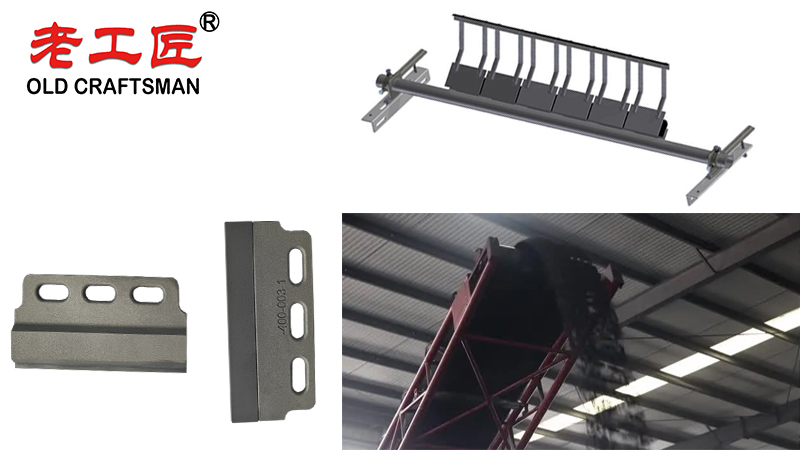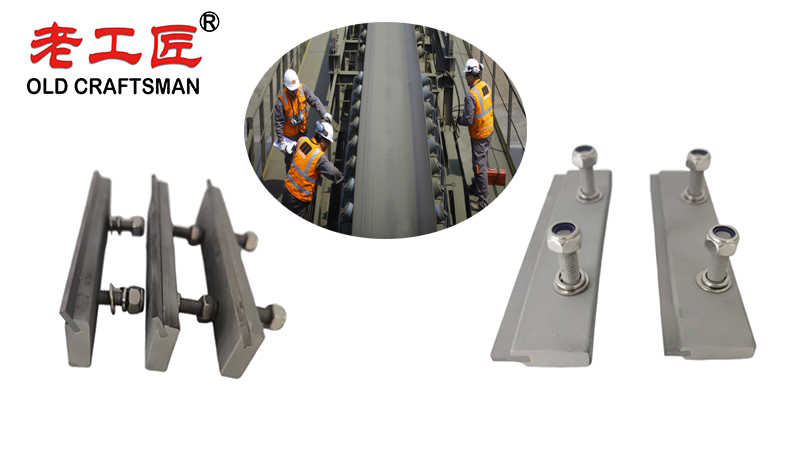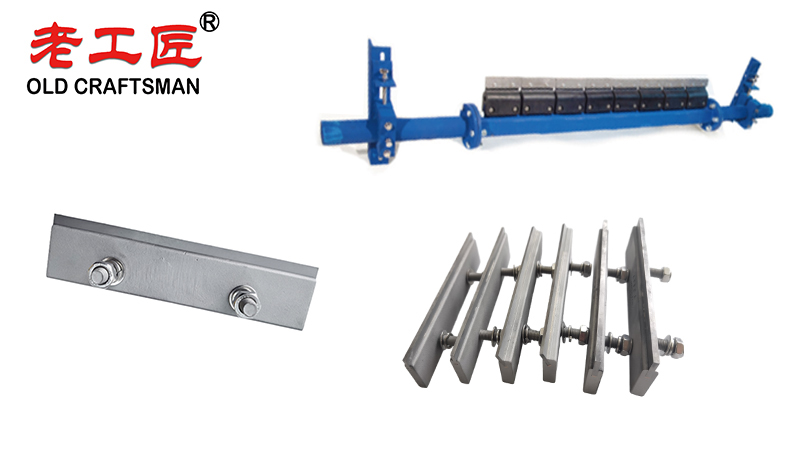Mining conveyor belt scrapers are critical for cleaning debris off belts to prevent misalignment, carryback, and damage.
Here’s a detailed breakdown of why tungsten carbide scrapers outperform those made from other materials like polyurethane, steel, and ceramic.

The Core Principle: Hardness vs. Toughness & Abrasion Resistance
The superiority of tungsten carbide stems from its unique combination of two key properties:
- Extreme Hardness: Tungsten carbide is one of the hardest materials used in industry, significantly harder than hardened steel or silica sand (the primary abrasive in most mining operations). On the Rockwell C scale, it can reach ~90 HRA, while hardened steel is typically around ~60 HRC.
- Exceptional Abrasion Resistance: Because it is harder than the material it’s scraping off (coal, iron ore, copper ore, etc.), it wears away at an extremely slow rate. The abrasive particles cannot easily gouge or cut into the carbide.
This combination makes it the “Gold Standard” for the most demanding applications.
Head-to-Head Comparison: Why Tungsten Carbide Wins
Let’s compare it directly to the most common alternatives.
1. vs. Polyurethane (Urethane)
| Feature | Tungsten Carbide | Polyurethane | Why Carbide Wins |
|---|---|---|---|
| Abrasion Resistance | Extremely High | Moderate to Good | Carbide lasts 10-20 times longer than urethane in highly abrasive environments. Urethane wears down quickly, requiring frequent replacement and adjustment. |
| Cleaning Efficiency | Consistently High | Degrades Quickly | A sharp carbide blade maintains a consistent cleaning edge. Urethane blades wear down and become less effective, allowing material carryback. |
| Operating Cost | Lower Lifetime Cost | Higher Lifetime Cost | While the initial cost of carbide is higher, its dramatically longer service life means far fewer replacements, less downtime, and lower labor costs. |
| Application Fit | Ideal for Heavy Abrasion | Best for Light Duty | For mining, where abrasion is extreme, urethane is often not a viable long-term solution. |
Verdict: Polyurethane is a softer, more flexible option that is better for protecting belts in less abrasive applications (e.g., food processing, packaging). For mining, it’s simply outmatched.
2. vs. Steel (Manganese, AR Steel)
| Feature | Tungsten Carbide | Hardened Steel | Why Carbide Wins |
|---|---|---|---|
| Hardness | ~90 HRA | ~60 HRC | Carbide is fundamentally harder. It resists abrasion from silica and other hard minerals far more effectively. |
| Abrasion Resistance | 5x to 10x Higher | Good, but limited | Steel blades wear down, losing their edge and profile. This leads to inefficient cleaning and can damage the belt if the worn steel edge becomes sharp. |
| Belt Damage Risk | Lower | Higher | A properly installed carbide blade wears in a way that maintains a belt-friendly profile. Worn steel can develop sharp, uneven edges that gouge the belt. |
| Service Life | Months to Years | Weeks to Months | The replacement interval for carbide is dramatically longer, maximizing production uptime. |
Verdict: Steel is strong and tough, but it lacks the necessary hardness to compete with the abrasiveness of mined materials. It’s a “brute force” solution that is less efficient and more costly in the long run.

3. vs. Ceramic (Alumina Oxide)
| Feature | Tungsten Carbide | Ceramic (Alumina) | Why Carbide Wins |
|---|---|---|---|
| Hardness | Very High | Slightly Higher | Ceramic can be harder, but this comes with a major trade-off. |
| Toughness (Impact Resistance) | Excellent | Brittle / Poor | This is the critical difference. Tungsten carbide can withstand the impacts of rocks and tramp metal without shattering. Ceramic is brittle and can chip or break upon impact, rendering it useless. |
| Mechanical Fastening | Easy and Robust | Difficult | Carbide tips can be brazed onto a steel holder very securely. Fixing brittle ceramic blocks is more challenging and prone to failure. |
| Consistency of Wear | Predictable | Can be Uneven | If a ceramic block chips, it creates an uneven scraping edge, which can lead to poor cleaning and belt damage. |
Verdict: While ceramic is incredibly hard and abrasion-resistant, its brittleness makes it unsuitable for the unpredictable and high-impact environment of a mining conveyor.
Summary of Key Advantages of Tungsten Carbide Scrapers
- Unmatched Service Life: The single biggest advantage. They last for years instead of months, drastically reducing maintenance schedules and inventory needs.
- Superior Cleaning Efficiency: They maintain a consistent, effective scraping edge throughout their life, minimizing material carryback (which improves safety, housekeeping, and belt tracking).
- Lower Total Cost of Ownership (TCO): The high initial cost is more than offset by massive savings in replacement parts, labor, and production downtime.
- Enhanced Belt Protection: When correctly tensioned, they wear in a way that is less likely to damage the conveyor belt casing compared to a worn, sharp steel blade.
- Optimal Balance of Properties: Tungsten carbide provides the perfect “sweet spot” with its combination of extreme hardness, good impact resistance (toughness), and structural integrity.
The One Caveat: Proper Installation is Key
The performance of tungsten carbide scrapers is contingent on correct installation. They must be mounted in the correct position (usually at the point where the belt leaves the head pulley) and with the correct tension. Too much pressure can cause premature wear to the belt itself, while too little renders them ineffective.

With decades of years of experience in manufacturing abrasion resistant steels, we specialize in high-quality tungsten carbide wear parts and AR steel plates designed to dramatically increase belt service life in the harshest conveyor system applications across multiple industries, including mining, quarrying, cement, and recycling. Our heat-treated, high-carbon wear-resistant solutions – from primary and secondary mining conveyor belt scrapers to custom cut edges and liners for dump trucks – deliver exceptional abrasion resistance and resist wear even when handling the most aggressive raw materials. By significantly extending equipment life and reducing downtime, our products not only improve operational efficiency but also lower the overall environmental impact through reduced material consumption and waste, while meeting or exceeding strict safety and health administration standards. We offer a wide range of proven wear-resistant solutions tailored to your specific needs, ensuring maximum performance and cost-effectiveness over the long term.
Conclusion:
In the harsh, high-abrasion world of mining, tungsten carbide scrapers outperform other materials by delivering a vastly longer service life, superior and consistent cleaning performance, and a lower total operational cost. Their unique material properties are perfectly suited to withstand the constant assault of abrasive materials that quickly destroy softer or more brittle alternatives.
“Zhuzhou Old Craftsman Precision Alloy Co., Ltd. could make tungsten carbide wear parts and make your equipment use life is tens of times longer than before! We specialize in providing customized carbide wear products solutions to meet the demanding requirements of industries such as aerospace, automotive, mining, and precision machining.”
Belt scarper Brazing brazingprocess CARBDIE HAMMER carbide Carbide belt scraper carbidebrazing carbide hammer Crusher CRUSHER HAMMER Informational Internal stress metal mining mold operate Refractory Brick Mold Secondary belt cleaner scraper stresses VSI VSI crusher wear plates welding work